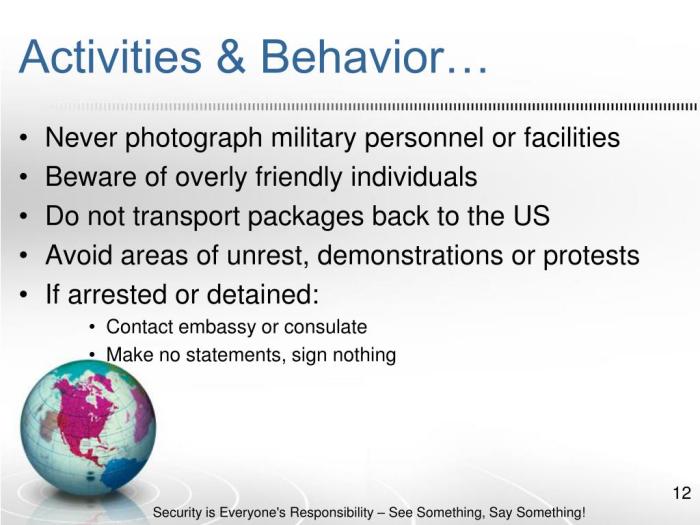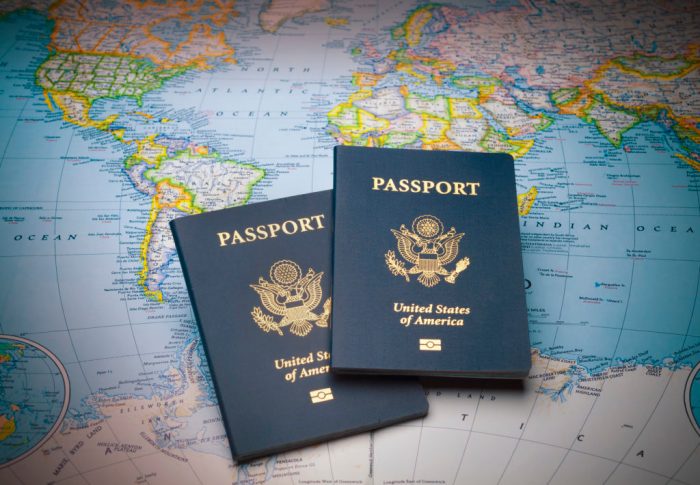How often must you receive a defensive foreign travel briefing? That depends! This isn’t a one-size-fits-all answer. Government employees in high-risk zones might get briefings before every trip, while a private sector employee on a short business trip to a relatively safe country might only need one. We’ll explore the factors influencing briefing frequency – threat level, trip duration, your role, and even your employer’s policies.
Get ready to learn how to stay safe and informed when traveling abroad.
This guide breaks down the frequency of defensive travel briefings for both government and private sector employees. We’ll examine the key topics covered in these briefings, the legal considerations involved, and provide real-world examples to illustrate the varying needs. By the end, you’ll have a clearer understanding of what to expect and how to best prepare for your international travels.
Frequency of Defensive Travel Briefings

Government agencies prioritize the safety and security of their employees traveling internationally, especially to high-risk areas. Defensive travel briefings are a crucial component of this effort, providing personnel with essential information and training to mitigate potential threats. The frequency of these briefings varies depending on several key factors.
Government Agency Briefing Frequency for High-Risk Regions
Standard briefing frequency for government employees traveling to high-risk regions isn’t universally defined across all agencies. However, a common practice involves mandatory briefings before departure, and often additional briefings or updates depending on the evolving threat landscape. The length and intensity of the briefing are tailored to the specifics of the assignment.
Factors Influencing Briefing Frequency
Several factors influence how often briefings are given. The threat level of the destination is paramount; higher threat levels necessitate more frequent briefings and more comprehensive training. The duration of the trip also plays a role: longer trips generally require more frequent updates to account for changing circumstances. The employee’s role and responsibilities are also considered; those with higher security clearances or those in more sensitive positions often receive more extensive and frequent briefings.
Comparison of Briefing Protocols Across Agencies
While core principles remain consistent, variations exist in briefing protocols across different government agencies. For example, the CIA might emphasize intelligence gathering and counter-surveillance techniques more than the Department of State, which may focus more on diplomatic protocol and cultural sensitivity alongside security awareness. The specific agency’s mission and operational context heavily influence the content and frequency of briefings.
Inter-agency collaboration often leads to the sharing of best practices, contributing to a general improvement in security protocols.
Typical Briefing Schedule Based on Threat Level
| Threat Level | Briefing Frequency | Briefing Content Highlights | Agency Example |
|---|---|---|---|
| High (e.g., active conflict zone) | Pre-departure, weekly updates, and on-site briefings as needed | Detailed security protocols, emergency procedures, potential threats, communication strategies, medical preparedness | Department of Defense |
| Medium (e.g., politically unstable region) | Pre-departure, monthly updates, and potential additional briefings based on emerging events | Regional security overview, personal safety measures, local laws and customs, communication protocols, basic first aid | Department of State |
| Low (e.g., stable region with minor risks) | Pre-departure briefing only, unless significant events occur | General safety advice, local customs and etiquette, emergency contact information | USAID |
| Minimal (e.g., Western European countries) | Often no specific briefing required, unless specific concerns arise | General safety reminders | Most Agencies |
Content of Defensive Travel Briefings
Defensive travel briefings are crucial for ensuring the safety and security of travelers in potentially hazardous environments. These briefings go beyond simple travel advisories, providing in-depth information and practical strategies to mitigate risks encountered in various parts of the world. The goal is to equip travelers with the knowledge and skills to navigate challenging situations and protect themselves effectively.The information shared during these briefings is tailored to the specific destination and the traveler’s itinerary.
This ensures that the advice provided is relevant and directly applicable to the potential threats faced. A standardized approach isn’t sufficient; the briefing must be dynamic and adaptable to the ever-changing global security landscape.
Key Topics Covered in Defensive Travel Briefings
Briefings typically cover a wide range of security concerns, focusing on practical steps travelers can take to minimize their vulnerability. These include detailed information about the political and social climate of the destination, common crime patterns, potential health risks, and emergency procedures. Participants learn about local laws and customs, cultural sensitivities, and how to interact safely with local authorities.
They also receive training on situational awareness, risk assessment, and personal security measures.
Specific Security Threats Addressed by Region
The specific threats highlighted in a briefing vary greatly depending on the region. For example, a briefing for travel to a politically unstable region might emphasize civil unrest, potential protests, and the risk of kidnapping. A briefing for a region with a high crime rate would focus on petty theft, scams, and violent crime prevention strategies. Travel to areas prone to natural disasters would involve preparedness for earthquakes, hurricanes, or tsunamis, including evacuation plans and emergency contact information.
Briefings for regions with significant health risks would cover disease prevention, access to medical care, and necessary vaccinations.
Potential Risks and Mitigation Strategies
Understanding the potential risks associated with international travel is paramount. Effective mitigation strategies are crucial for a safe trip.
| Potential Risk | Mitigation Strategy |
|---|---|
| Political Instability (e.g., protests, civil unrest) | Monitor local news, avoid protest areas, have backup travel plans, register with your embassy. |
| Crime (e.g., theft, scams, assault) | Maintain situational awareness, avoid displaying valuables, use reputable transportation, be cautious at night. |
| Natural Disasters (e.g., earthquakes, floods, hurricanes) | Check weather forecasts, have emergency supplies, know evacuation routes, purchase travel insurance. |
| Health Risks (e.g., infectious diseases, medical emergencies) | Consult your doctor about necessary vaccinations and medications, have travel insurance, know the location of medical facilities. |
Practical Advice on Personal Security, Emergency Communication, and Medical Preparedness, How often must you receive a defensive foreign travel briefing
Practical advice is essential for travelers to stay safe and respond effectively in unexpected situations.
- Personal Security: Always be aware of your surroundings, avoid walking alone at night, keep valuables secure, and trust your instincts. If you feel unsafe, remove yourself from the situation immediately.
- Emergency Communication: Share your itinerary with family and friends, have emergency contact information readily available, and know how to contact your embassy or consulate.
- Medical Preparedness: Pack a basic first-aid kit, have copies of your medical records and insurance information, and be aware of local medical facilities and emergency services.
Illustrative Examples of Briefing Scenarios

Understanding the frequency and content of defensive foreign travel briefings depends heavily on the specific circumstances of the trip. Let’s look at contrasting scenarios to illustrate this point. The key difference lies in the level of risk and the duration of exposure to potential threats.
Frequent Briefings: Ongoing Conflict Zone
This scenario involves travel to an active conflict zone, such as a region experiencing ongoing warfare or significant civil unrest. Frequent briefings are crucial for adapting to rapidly changing security situations.
- Frequency: Daily, or even multiple times daily, depending on the volatility of the situation.
- Content: Briefings would cover immediate threats, including locations of active fighting, potential attacks (e.g., IEDs, ambushes), evacuation routes, and updated security protocols. They would also address local laws, cultural sensitivities, and communication strategies during emergencies. Information from local intelligence sources and real-time updates from news agencies would be crucial. For example, a briefing might detail a recent increase in insurgent activity in a specific area, advising travelers to avoid that route and use an alternate, safer path.
Infrequent Briefings: Short Business Trip to a Safe Country
This scenario involves a short business trip to a country generally considered safe for travelers. The risk level is significantly lower, reducing the need for frequent briefings.
- Frequency: A single pre-departure briefing might suffice. A quick check-in could be scheduled if a significant security incident occurs before or during the trip.
- Content: The briefing would focus on general safety advice, including local laws, emergency contact information (local embassy, etc.), transportation safety, common scams, and basic cultural awareness. For instance, a briefing might highlight the importance of using registered taxis and being aware of pickpockets in crowded areas. It would also cover standard procedures for handling emergencies like loss of passport or medical issues.
A less detailed overview of potential risks (e.g., petty crime) would be sufficient.
So, how often should you receive a defensive foreign travel briefing? The answer hinges on a careful assessment of risk. Whether you’re a government employee or in the private sector, understanding the threat level, trip duration, and your specific role is crucial. Regular briefings aren’t just about ticking boxes; they’re about equipping you with the knowledge and strategies to stay safe and make informed decisions while traveling abroad.
Remember, preparation is key to a successful and secure trip.
Question Bank: How Often Must You Receive A Defensive Foreign Travel Briefing
What constitutes a “high-risk” region?
High-risk regions are typically defined by factors like ongoing conflict, political instability, high crime rates, or significant health risks. Specific criteria vary depending on the agency or organization.
Are there specific legal penalties for employers who don’t provide adequate briefings?
Legal penalties vary by country and jurisdiction. However, failure to provide adequate safety briefings can expose employers to liability in case of employee injury or harm during foreign travel.
What if my company doesn’t offer travel briefings?
If your company doesn’t provide briefings, you should proactively seek out information from government resources or private security consultants specializing in travel safety. Your personal safety is your responsibility.
Can I get a briefing even if my trip is personally funded?
Yes, many government agencies and private security firms offer briefings to individuals traveling internationally, though these might come at a cost.


